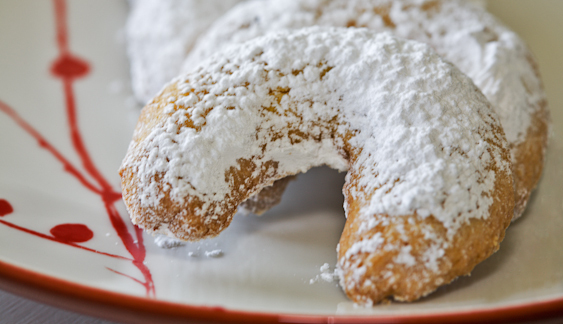Crumiri (Cornmeal Butter Cookies)

introduction
Crumiri are cornmeal cookies, provenance Piedmont, possessing classic European snap (not bend) and a buttery crumb. Traditionally piped or shaped into little horseshoes and dusted—like many things dolce—with powdered sugar, they have a ravishingly fine finish (finer even than the word “sandy” suggests), and their overall effect is appealingly uncomplicated. The American homage to crumiri has tended to result in a demure, dressy cookie, rolled and iced rather than hand-shaped and powdered. Prettiness notwithstanding, American cornmeal cookies lose a lot in translation, as their texture frequently falls well short of “fine” and is light years from ravishing.
The problem with American cornmeal cookies goes directly to the problem with commercial cornmeal: It’s not coarse enough to produce a decent skillet cornbread, but far too coarse to produce a decent cookie. Anson Mills Fine Yellow Cornmeal, on the other hand, drifts from the bag damp, fragrant, and just one sifter screen shy of corn flour. In both versions of our crumiri, the sweet flavor of corn lingers on the tongue and a subtle, buttery granulation between the teeth.
equipment mise en place
For this recipe, you will need a digital kitchen scale, a mixing bowl, a whisk, a stand mixer with the flat-beater attachment, a rubber spatula, three baking sheets, and parchment paper. A ruler might come in handy and a fine-mesh sieve works best when sifting the confectioners’ sugar.
-
-
7ounces (1⅓ cups plus 2 tablespoons) unbleached all-purpose flour or an equal amount by weight of Anson Mills Colonial Style Fine Cloth-Bolted Pastry Flour
-
5ounces (1 cup) Anson Mills Fine Yellow Cornmeal or Fine White Cornmeal
-
Scant ½ teaspoon fine sea salt
-
8ounces (16 tablespoons) unsalted European-style butter, room temperature
-
5.25ounces (¾ cup) superfine sugar
-
1large egg
-
½teaspoon vanilla extract
-
¼teaspoon almond extract
-
3.5ounces (1 sifted cup) confectioners’ sugar
-
-
Turn the flour, cornmeal, and salt into a medium mixing bowl and whisk to combine. In the bowl of a stand mixer fitted with the flat-beater attachment, beat the butter on medium speed until light and fluffy, about 2 minutes. Scrape down the bowl. Add the sugar and beat on medium speed until the sugar has dissolved and the mixture is light and aerated, about 3 minutes, pausing once to scrape down the bowl. With the mixer running on low speed, add the egg and the vanilla and almond extracts; beat until incorporated, then add the dry ingredients and mix on low speed just until the mixture forms a cohesive dough. Detach the bowl from the mixer and give the dough a few turns with a rubber spatula.
-
Cover the mixing bowl with plastic wrap and refrigerate the dough for about 1 hour (longer refrigeration is fine, but the dough will require a short time at room temperature to soften before shaping). When you are ready to bake, remove the dough from the refrigerator. Adjust an oven rack to the middle position and heat the oven to 325 degrees. Line three baking sheets with parchment paper.
-
Tape a sheet of parchment paper to the work surface to keep the dough from sticking as you shape it. Working 4 or 5 at a time, break off small bits of dough with your fingers and roll them into 1¼-inch balls (0.5 ounce in weight, or about the size of a shell-on hazelnut) lightly between the palms. Roll each ball on the parchment paper into a skinny snake, 4 inches long, and untapered on the ends. If the dough becomes too soft, flour your hands very lightly. Grasping the ends lightly, lift each dough snake onto a prepared baking sheet, bending it into a U to create a horseshoe shape; space the cookies about 2 inches apart. You should end up with a total of about 48 cookies.
-
Bake the cookies one baking sheet at a time until golden brown on the edges and bottoms, about 20 minutes, rotating the pan from front to back halfway through the baking time. Let the cookies cool completely on the baking sheet, then sift confectioners’ sugar over them, turning to coat the bottoms as well.